engine coolant KIA Optima Hybrid 2013 3.G Owner's Guide
[x] Cancel search | Manufacturer: KIA, Model Year: 2013, Model line: Optima Hybrid, Model: KIA Optima Hybrid 2013 3.GPages: 394, PDF Size: 8.63 MB
Page 317 of 394
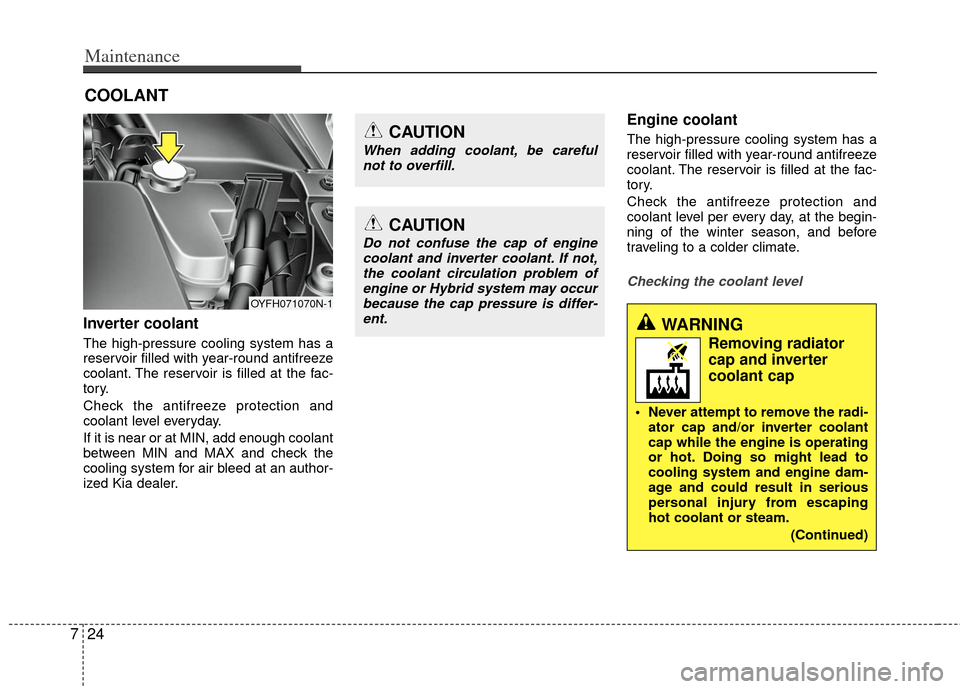
Maintenance
24
7
COOLANT
Inverter coolant
The high-pressure cooling system has a
reservoir filled with year-round antifreeze
coolant. The reservoir is filled at the fac-
tory.
Check the antifreeze protection and
coolant level everyday.
If it is near or at MIN, add enough coolant
between MIN and MAX and check the
cooling system for air bleed at an author-
ized Kia dealer.
Engine coolant
The high-pressure cooling system has a
reservoir filled with year-round antifreeze
coolant. The reservoir is filled at the fac-
tory.
Check the antifreeze protection and
coolant level per every day, at the begin-
ning of the winter season, and before
traveling to a colder climate.
Checking the coolant level
OYFH071070N-1
CAUTION
When adding coolant, be careful
not to overfill.
WARNING
Removing radiator
cap and inverter
coolant cap
Never attempt to remove the radi- ator cap and/or inverter coolant
cap while the engine is operating
or hot. Doing so might lead to
cooling system and engine dam-
age and could result in serious
personal injury from escaping
hot coolant or steam.
(Continued)
CAUTION
Do not confuse the cap of enginecoolant and inverter coolant. If not,the coolant circulation problem ofengine or Hybrid system may occur because the cap pressure is differ-ent.
Page 318 of 394

725
Maintenance
Check the condition and connections of
all cooling system hoses and heater
hoses. Replace any swollen or deterio-
rated hoses.
The coolant level should be filled
between F and L marks on the side of the
coolant reservoir when the engine is
cool.
If the coolant level is low, add enough
distilled (deionized) water to provide pro-
tection against freezing and corrosion.
Bring the level to F, but do not overfill. If
frequent additions are required, see an
authorized Kia dealer for a cooling sys-
tem inspection.
(Continued)
The engine coolant level is influ-enced by hybrid system tempera-
ture. Before filling the engine
coolant and/or inverter coolant,
turn the hybrid vehicle off, fill the
engine coolant and/or inverter
coolant carefully.
Turn the engine off and wait until it cools down. Use extreme care
when removing the radiator cap.
Wrap a thick towel around it, and
turn it counterclockwise slowly to
the first stop. Step back while the
pressure is released from the
cooling system. When you are
sure all the pressure has been
released, press down on the cap,
using a thick towel, and continue
turning counterclockwise to
remove it.
Even if the engine is not operat- ing, do not remove the radiator
cap and/or inverter or the drain
plug while the engine and radia-
tor are hot. Hot coolant and
steam may still blow out under
pressure, causing serious injury.
OYFH071005N
WARNING
The electronic motor
(cooling fan) is con-
trolled by engine
coolant temperature,
refrigerant pressure and
vehicle speed. It may sometimes
operate even when the engine is
not running. Use extreme caution
when working near the blades of
the cooling fan so that you are not
injured by the rotating fan blades.
As the engine coolant temperature
decreases, the electric motor will
automatically shut off. This is a nor-
mal condition.
Page 319 of 394
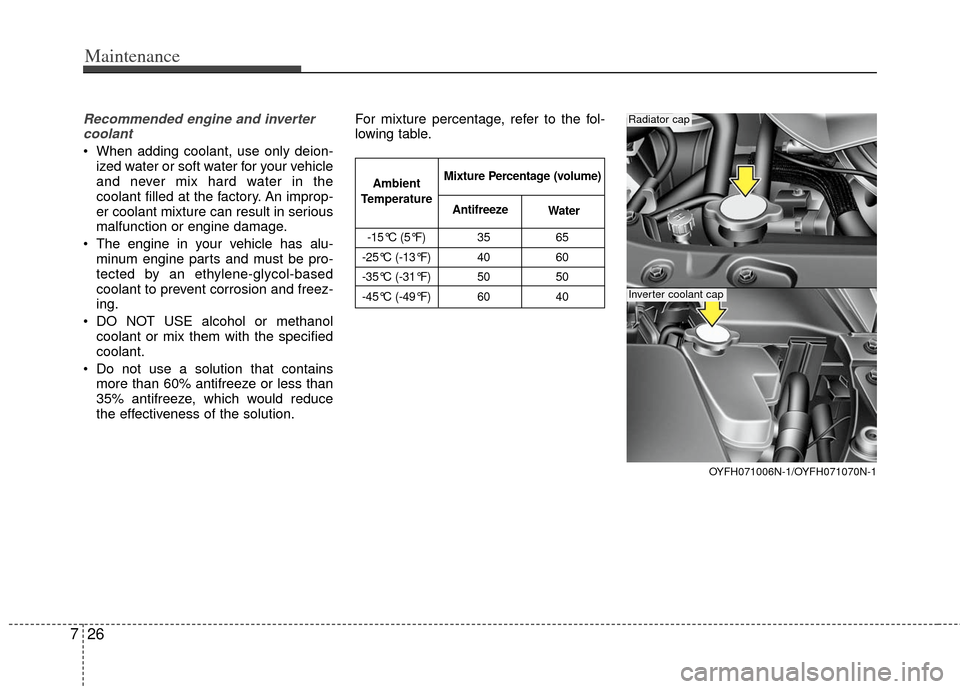
Maintenance
26
7
Recommended engine and inverter
coolant
When adding coolant, use only deion- ized water or soft water for your vehicle
and never mix hard water in the
coolant filled at the factory. An improp-
er coolant mixture can result in serious
malfunction or engine damage.
The engine in your vehicle has alu- minum engine parts and must be pro-
tected by an ethylene-glycol-based
coolant to prevent corrosion and freez-
ing.
DO NOT USE alcohol or methanol coolant or mix them with the specified
coolant.
Do not use a solution that contains more than 60% antifreeze or less than
35% antifreeze, which would reduce
the effectiveness of the solution. For mixture percentage, refer to the fol-
lowing table.
-15°C (5°F) 35
65
-25°C (-13°F) 40 60
-35°C (-31°F) 50 50
-45°C (-49°F) 60 40
Ambient
Temperature Mixture Percentage (volume)
Antifreeze Water
OYFH071006N-1/OYFH071070N-1
Radiator cap
Inverter coolant cap
Page 320 of 394
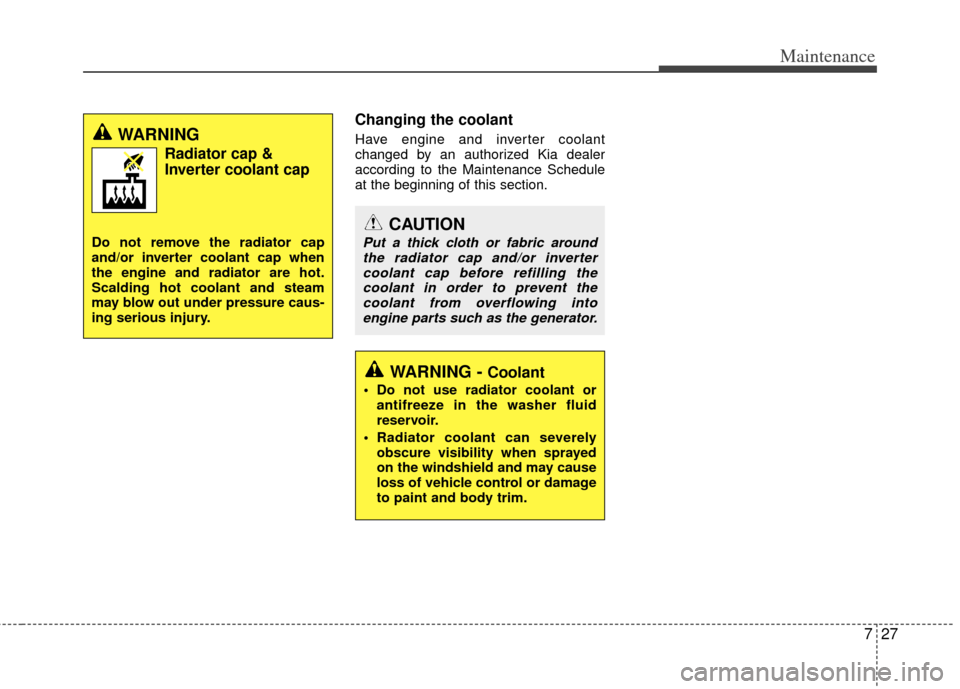
727
Maintenance
Changing the coolant
Have engine and inverter coolant
changed by an authorized Kia dealer
according to the Maintenance Schedule
at the beginning of this section.
WARNING - Coolant
Do not use radiator coolant orantifreeze in the washer fluid
reservoir.
Radiator coolant can severely obscure visibility when sprayed
on the windshield and may cause
loss of vehicle control or damage
to paint and body trim.
CAUTION
Put a thick cloth or fabric aroundthe radiator cap and/or invertercoolant cap before refilling thecoolant in order to prevent thecoolant from overflowing intoengine parts such as the generator.
WARNING
Radiator cap &
Inverter coolant cap
Do not remove the radiator cap
and/or inverter coolant cap when
the engine and radiator are hot.
Scalding hot coolant and steam
may blow out under pressure caus-
ing serious injury.
Page 362 of 394
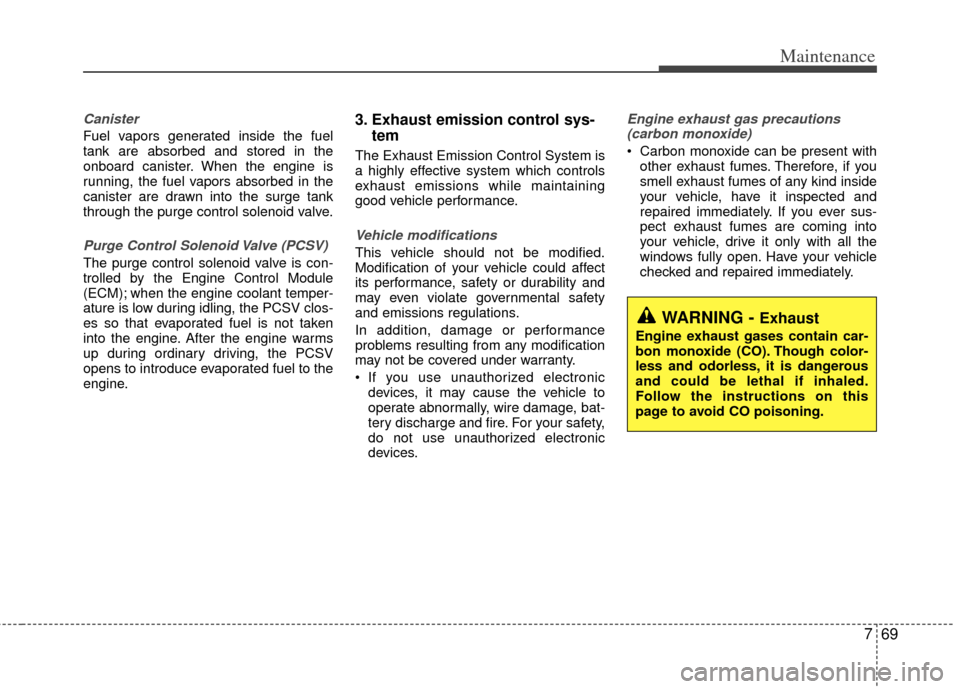
769
Maintenance
Canister
Fuel vapors generated inside the fuel
tank are absorbed and stored in the
onboard canister. When the engine is
running, the fuel vapors absorbed in the
canister are drawn into the surge tank
through the purge control solenoid valve.
Purge Control Solenoid Valve (PCSV)
The purge control solenoid valve is con-
trolled by the Engine Control Module
(ECM); when the engine coolant temper-
ature is low during idling, the PCSV clos-
es so that evaporated fuel is not taken
into the engine. After the engine warms
up during ordinary driving, the PCSV
opens to introduce evaporated fuel to the
engine.
3. Exhaust emission control sys-tem
The Exhaust Emission Control System is
a highly effective system which controls
exhaust emissions while maintaining
good vehicle performance.
Vehicle modifications
This vehicle should not be modified.
Modification of your vehicle could affect
its performance, safety or durability and
may even violate governmental safety
and emissions regulations.
In addition, damage or performance
problems resulting from any modification
may not be covered under warranty.
If you use unauthorized electronic
devices, it may cause the vehicle to
operate abnormally, wire damage, bat-
tery discharge and fire. For your safety,
do not use unauthorized electronic
devices.
Engine exhaust gas precautions(carbon monoxide)
Carbon monoxide can be present with other exhaust fumes. Therefore, if you
smell exhaust fumes of any kind inside
your vehicle, have it inspected and
repaired immediately. If you ever sus-
pect exhaust fumes are coming into
your vehicle, drive it only with all the
windows fully open. Have your vehicle
checked and repaired immediately.
WARNING - Exhaust
Engine exhaust gases contain car-
bon monoxide (CO). Though color-
less and odorless, it is dangerous
and could be lethal if inhaled.
Follow the instructions on this
page to avoid CO poisoning.
Page 368 of 394
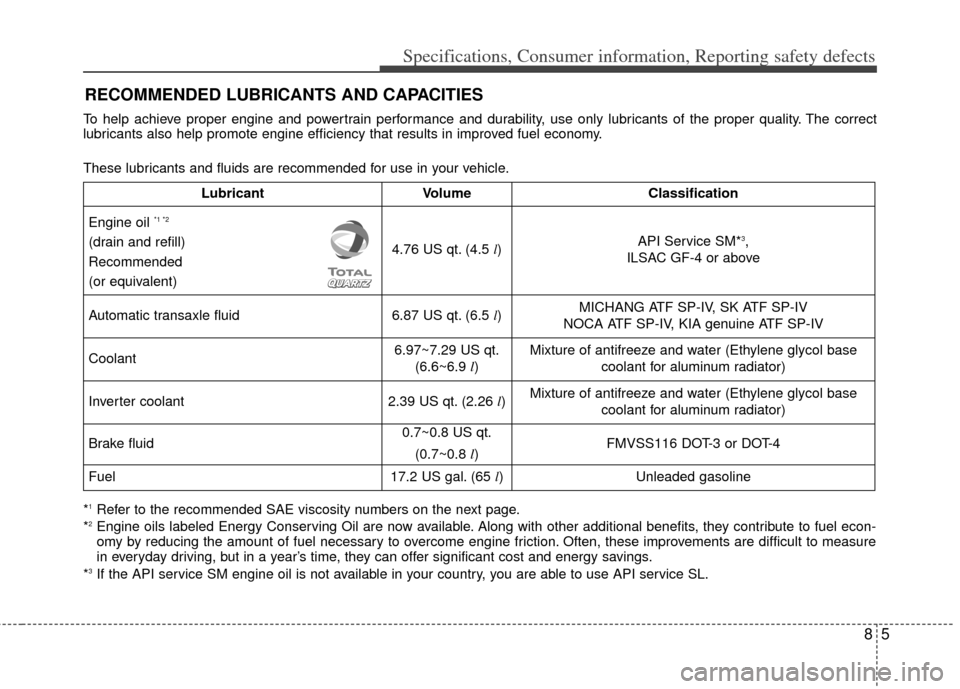
5
Specifications, Consumer information, Reporting safety defects
RECOMMENDED LUBRICANTS AND CAPACITIES
To help achieve proper engine and powertrain performance and durability, use only lubricants of the proper quality. The correct
lubricants also help promote engine efficiency that results in improved fuel economy.
These lubricants and fluids are recommended for use in your vehicle.
*
1Refer to the recommended SAE viscosity numbers on the next page.
*2Engine oils labeled Energy Conserving Oil are now available. Along with other additional benefits, they contribute to fuel econ-
omy by reducing the amount of fuel necessary to overcome engine friction. Often, these improvements are difficult to measure
in everyday driving, but in a year’s time, they can offer significant cost and energy savings.
*
3If the API service SM engine oil is not available in your country, you are able to use API service SL.
LubricantVolumeClassification
Engine oil *1 *2
(drain and refill)
Recommended
(or equivalent)4.76 US qt. (4.5 l)API Service SM*3,
ILSAC GF-4 or above
Automatic transaxle fluid6.87 US qt. (6.5 l)MICHANG ATF SP-IV, SK ATF SP-IV
NOCA ATF SP-IV, KIA genuine ATF SP-IV
Coolant 6.97~7.29 US qt. (6.6~6.9 l)Mixture of antifreeze and water (Ethylene glycol base
coolant for aluminum radiator)
Inverter coolant2.39 US qt. (2.26 l)Mixture of antifreeze and water (Ethylene glycol basecoolant for aluminum radiator)
Brake fluid0.7~0.8 US qt.
(0.7~0.8 l)FMVSS116 DOT-3 or DOT-4
Fuel17.2 US gal. (65 l)Unleaded gasoline
8
Page 388 of 394

I3
Index
Camera (Rear view) ··················\
··················\
··················\
·4-84
Capacities (Lubricants) ··················\
··················\
················8-5
Capacity/weight ··················\
··················\
··················\
·········8-2
CareExterior care ··················\
··················\
··················\
··········7-61
Interior care ··················\
··················\
··················\
···········7-66
Tire care ··················\
··················\
··················\
················7-38
Cargo weight ··················\
··················\
··················\
············5-45
Center console storage ··················\
··················\
·············4-111
Central door lock switch··················\
··················\
············4-14
Certification label ··················\
··················\
··················\
····5-43
Certification label ··················\
··················\
··················\
······8-7
Changing tires (with spare tire) ··················\
··················\
·6-13
Checking tire inflation pressure··················\
··················\
·7-39
Child restraint system ··················\
··················\
················3-27 Lower anchor system··················\
··················\
···············3-31
Seat belt ··················\
··················\
··················\
·················3-16\
Tether anchor system ··················\
··················\
···············3-30
Child-protector rear door lock ··················\
··················\
···4-15
Climate control air filter ··················\
··················\
·4-106, 7-31
Clock (Digital) ··················\
··················\
··················\
·······4-115
Clothes hanger ··················\
··················\
··················\
·······4-115
Combined instrument, see instrument cluster ···············4-47
Compact spare tire (with spare tire) ··················\
············6-19
Compact spare tire replacement ··················\
··················\
7-42
Coolant ··················\
··················\
··················\
··················\
···7-24 Cooling fluid, see engine coolant ··················\
················7-24
Crankcase emission control system ··················\
·············7-68
Cruise control system ··················\
··················\
················5-27
Cup holder ··················\
··················\
··················\
·············4-113
Curtain air bag ··················\
··················\
··················\
·········3-49
Dashboard illumination, see instrument panel
illumination··················\
··················\
··················\
············4-47
Dashboard, see instrument cluster ··················\
···············4-47
Defogging (Windshield) ··················\
··················\
··········4-108
Defogging logic (Windshield) ··················\
··················\
·4-109
Defroster (Rear window) ··················\
··················\
···········4-96
Defrosting (Windshield) ··················\
··················\
··········4-108
Digital clock··················\
··················\
··················\
···········4-115
Dimensions ··················\
··················\
··················\
················8-3
Display illumination, see instrument panel illumination··················\
··················\
··················\
············4-47
Displays, see instrument cluster ··················\
··················\
4-47
Door locks··················\
··················\
··················\
················4-12 Central door lock switch ··················\
··················\
·········4-14
Child-protector rear door lock ··················\
··················\
·4-15
Drinks holders, see cup holders··················\
·················4-11\
3
Driver's 3-point system with evergency locking retractor··················\
··················\
··················\
··················\
3-18
Driver's air bag··················\
··················\
··················\
·········3-45
Driving at night ··················\
··················\
··················\
········5-34
C
D
Page 389 of 394

Index
4I
Driving in flooded areas ··················\
··················\
············5-35
Driving in the rain··················\
··················\
··················\
····5-35
Economical operation ··················\
··················\
················5-31
Electric chromic mirror (ECM) with HomeLink system ··················\
··················\
··················\
··················\
··4-37
Electric power steering ··················\
··················\
··············4-34
Electronic stability control (ESC) ··················\
···············5-20
Emergency starting ··················\
··················\
··················\
····6-5 Jump starting ··················\
··················\
··················\
···········6-5
Push starting ··················\
··················\
··················\
············6-6
Emergency while driving ··················\
··················\
·············6-3
Emission control system ··················\
··················\
············7-68 Crankcase emission control system··················\
···········7-68
Evaporative emission control System ··················\
·······7-68
Exhaust emission control system ··················\
··············7-69
Engine ··················\
··················\
··················\
··················\
······8-2
Engine compartment ··················\
··················\
············2-4, 7-2
Engine coolant ··················\
··················\
··················\
·········7-24
Engine number ··················\
··················\
··················\
···········8-8
Engine oil ··················\
··················\
··················\
·················7-22\
Engine overheats ··················\
··················\
··················\
········6-7
Engine start/stop button ··················\
··················\
···············5-5
Engine temperature gauge ··················\
··················\
·········4-50 Evaporative emission control System ··················\
··········7-68
Exhaust emission control system··················\
·················7-69\
Explanation of scheduled maintenance items ···············7-19
Exterior care··················\
··················\
··················\
·············7-61
Flat tire (with spare tire) ··················\
··················\
············6-13
Changing tires··················\
··················\
··················\
········6-14
Compact spare tire ··················\
··················\
··················\
·6-19
Jack and tools ··················\
··················\
··················\
········6-13
Removing and storing the spare tire···········\
·················6-14\
Flat tire (with tire mobility kit) ··················\
··················\
·6-21
Floor mat anchor(s) ··················\
··················\
·················4-11\
6
Fluid Brakes fluid ··················\
··················\
··················\
···········7-28
Washer fluid··················\
··················\
··················\
···········7-29
Front passenger and rear seat 3-point system with combination locking retractor ··················\
··················\
·3-19
Front seat adjustment ··················\
··················\
··················\
·3-4
Fuel filler lid ··················\
··················\
··················\
············4-25
Fuel gauge··················\
··················\
··················\
················4-49
Fuel requirements ··················\
··················\
··················\
······1-3
Fuse/relay panel description ··················\
··················\
······7-55
Fuses ··················\
··················\
··················\
··················\
······7-51 Fuse/relay panel description ··················\
··················\
····7-55
Instrument panel fuse ··················\
··················\
··············7-52
Memory fuse··················\
··················\
··················\
··········7-52
Multi fuse ··················\
··················\
··················\
··············7-54
E
F